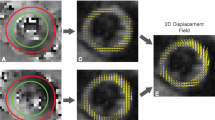Abstract
Objective
Point spread function (PSF) mapping enables estimating the displacement fields required for distortion correction of echo planar images. Recently, a highly accelerated approach was introduced for estimating displacements from the phase slope of under-sampled PSF mapping data. Sampling schemes with varying spacing were proposed requiring stepwise phase unwrapping. To avoid unwrapping errors, an alternative approach applying the concept of finite rate of innovation to PSF mapping (FRIP) is introduced, using a pattern search strategy to locate the PSF peak, and the two methods are compared.
Materials and methods
Fully sampled PSF data was acquired in six subjects at 3.0 T, and distortion maps were estimated after retrospective under-sampling. The two methods were compared for both previously published and newly optimized sampling patterns. Prospectively under-sampled data were also acquired. Shift maps were estimated and deviations relative to the fully sampled reference map were calculated.
Results
The best performance was achieved when using FRIP with a previously proposed sampling scheme. The two methods were comparable for the remaining schemes. The displacement field errors tended to be lower as the number of samples or their spacing increased.
Conclusion
A robust method for estimating the position of the PSF peak has been introduced.



Similar content being viewed by others
References
Jezzard P, Balaban RS (1995) Correction for geometric distortion in echo planar images from B0 field variations. Magn Reson Med 34:65–73
Robson MD, Gore JC, Constable RT (1997) Measurement of the point spread function in MRI using constant time imaging. Magn Reson Med 38:733–740
Zaitsev M, Hennig J, Speck O (2004) Point spread function mapping with parallel imaging techniques and high acceleration factors: fast, robust, and flexible method for echo-planar imaging distortion correction. Magn Reson Med 52:1156–1166
Zeng H, Constable RT (2002) Image distortion correction in EPI: comparison of field mapping with point spread function mapping. Magn Reson Med 48:137–146
In MH, Speck O (2012) Highly accelerated PSF-mapping for EPI distortion correction with improved fidelity. Magn Reson Mater Phy Biol Med 25:183–192
Dragonu I, Lange T, Baxan N, Snyder J, Hennig J, Zaitsev M (2013) Accelerated point spread function mapping using signal modeling for accurate echo-planar imaging geometric distortion correction. Magn Reson Med 69:1650–1656
Vetterli M, Marziliano P, Blu T (2002) Sampling signals with finite rate of innovation. IEEE Trans Signal Process 50:1417–1428
Dragotti PL, Homann F (2009) Sampling signals with finite rate of innovation in the presence of noise. In: 2009 IEEE Int. Conf. Acoust. Speech Signal Process. IEEE, pp 2941–2944
Blu T, Dragotti P-L (2008) Sparse sampling of signal innovations. Signal Process Mag IEEE 25:31–40
Ma D, Gulani V, Seiberlich N, Liu K, Sunshine JL, Duerk JL, Griswold MA (2013) Magnetic resonance fingerprinting. Nature 495:187–192
Nunes RG, Hajnal JV (2014) Highly accelerated Point-Spread Function mapping based on Finite Rate of Innovation for EPI distortion correction. EJNMMI Phys 1:A45
Oh C, Hilal S, Cho Z, Oh C, Hilal S CZ (1988) Selective partial inversion recovery (SPIR) in steady state for selective saturation magnetic resonance imaging (MRI). In: Proceedings of the 7th Annual Meeting of ISMRM, San Francisco, USA, p 324
Smith SM (2002) Fast robust automated brain extraction. Hum Brain Mapp 17:143–155
Buonocore MH, Gao L (1997) Ghost artifact reduction for echo planar imaging using image phase correction. Magn Reson Med 38:89–100
Jenkinson M, Beckmann CF, Behrens TEJ, Woolrich MW, Smith SM (2012) FSL. Neuroimage 62:782–790
Xiang Q-S, Ye FQ (2007) Correction for geometric distortion and N/2 ghosting in EPI by phase labeling for additional coordinate encoding (PLACE). Magn Reson Med 57:731–741
Oh SH, Chung JY, In MH, Zaitsev M, Kim YB, Speck O, Cho ZH (2012) Distortion correction in EPI at ultra-high-field MRI using PSF mapping with optimal combination of shift detection dimension. Magn Reson Med 68:1239–1246
In MH, Posnansky O, Beall EB, Lowe MJ, Speck O (2015) Distortion correction in EPI using an extended PSF method with a reversed phase gradient approach. PLoS One. https://doi.org/10.1371/journal.pone.0116320
Bowtell R, McIntyre DJO, Commandre M-J, Glover PM, Mansfield P (1994) Correction of geometric distortion in echo planar images. In: Proceedings of the 2nd Annual Meeting of ISMRM, San Francisco, USA, p 411
Andersson JLR, Skare S, Ashburner J (2003) How to correct susceptibility distortions in spin-echo echo-planar images: application to diffusion tensor imaging. Neuroimage 20:870–888
Holland D, Kuperman JM, Dale AM (2010) Efficient correction of inhomogeneous static magnetic field-induced distortion in Echo Planar Imaging. Neuroimage 50:175–183
Chung JY, In MH, Oh SH, Zaitsev M, Speck O, Cho ZH (2011) An improved PSF mapping method for EPI distortion correction in human brain at ultra high field (7T). Magn Reson Mater Phy Biol Med 24:179–190
Pruessmann KP, Weiger M, Scheidegger MB, Boesiger P (1999) SENSE: sensitivity encoding for fast MRI. Magn Reson Med 42:952–962
Acknowledgements
RGN was funded by the Fundação para a Ciência e a Tecnologia grants UID/BIO/00645/2013, UID/EEA/50009/2013 and IF/00364/2013.
Author information
Authors and Affiliations
Contributions
Nunes: protocol/project development; data collection or management; data analysis. Hajnal: protocol/project development.
Corresponding author
Ethics declarations
Ethical approval
All procedures performed in studies involving human participants were in accordance with the ethical standards of the institutional and/or national research committee and with the 1964 Helsinki Declaration and its later amendments or comparable ethical standards.
Informed consent
Informed consent was obtained from all individual participants included in the study.
Conflict of interest
The authors declare that they have no conflict of interest.
Rights and permissions
About this article
Cite this article
Nunes, R.G., Hajnal, J.V. Distortion correction of echo planar images applying the concept of finite rate of innovation to point spread function mapping (FRIP). Magn Reson Mater Phy 31, 449–456 (2018). https://doi.org/10.1007/s10334-017-0669-1
Received:
Revised:
Accepted:
Published:
Issue Date:
DOI: https://doi.org/10.1007/s10334-017-0669-1




